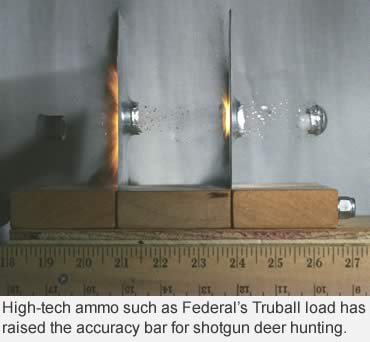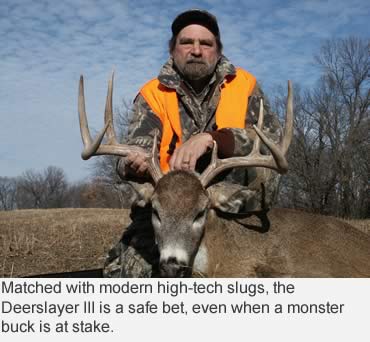By Ralph M. Lermayer
Ithaca’s Deerslayer is back, and this one in 20 gauge shoots as well as the original.
One would think that when a large percentage of the hunting public wanted a product, all of the manufacturers would trip over themselves to provide it, especially in today’s competitive firearms market. Well, factor this: Thirty-five percent of the hunters who head afield after whitetails each year must use a slug gun. That’s a large chunk of market.
Ammo makers are all over it with an assortment of slugs ranging from the original Brenneke and Foster designs on to innovative performers like Remington’s Buckhammer, Winchester’s Partition Gold and Federal’s Truball. From saboted options reaching 1,900 fps to high-performance, reduced-recoil loads, today’s slug choices are state-of-the-art and capable of 150-yard accuracy. The market is there, the ammo is ready, but where are the guns to take advantage of that kind of accuracy?
Optional aftermarket rifled barrels complete with sights are available for every major shotgun, and many, if not most, woodland hunters can get satisfactory accuracy out of them. But although the ammo is capable of close to minute-of-angle performance, you’ll rarely get it from an aftermarket barrel.
Interchangeable barrels mean, by necessity, a loose and sloppy fit, and that never equates to accuracy. You also have the problem of heavy shotgun triggers and varying contact between the barrel and the usually movable fore-end.
Nope, aftermarket barrels are okay up close, but to get long-range accuracy from a shotgun today means a special bolt action like the great old Mossberg, a custom dedicated slug gun costing a pile (worth every penny) or one of the best-shooting commercial slug shotguns ever made, the Ithaca Deerslayer III.
 Most of us grew up around Ithaca’s legendary Model 37 in one form or another. It was one of John Browning’s last designs, first sold to Remington and later to Ithaca, a company founded in Ithaca, N.Y., in 1883. Ithaca became a trusted brand name for decades, and anyone who has ever shucked the action on a Model 37 or felt their 20-gauge lightweight jump to the shoulder knows why: They’re great guns.
Most of us grew up around Ithaca’s legendary Model 37 in one form or another. It was one of John Browning’s last designs, first sold to Remington and later to Ithaca, a company founded in Ithaca, N.Y., in 1883. Ithaca became a trusted brand name for decades, and anyone who has ever shucked the action on a Model 37 or felt their 20-gauge lightweight jump to the shoulder knows why: They’re great guns.
It was a natural then, for a company based in the heart of shotgun-only Eastern deer country to pay heed to what the growing number of slug shooters wanted: accuracy. In 1959, Ithaca introduced their first Deerslayer. It was still a smoothbore, but it wore rifle sights, a cylinder choke and a barrel and chamber cut to tighter tolerances to enhance slug accuracy. It was the first-ever production slug gun from any manufacturer.
In 1988, the Deerslayer was provided with a rifled barrel. It was still basically a Model 37 with a removable barrel, but things were steadily getting better for slug hunters, and it kept improving. By 1996, mandated slug use was expanding along with population growth, and it wasn’t just an Eastern mandate anymore. States like Montana, Iowa and Idaho were setting aside slug-only areas.
Ammunition manufacturers began paying attention, and soon high-tech slugs and saboted bullets appeared, further raising the accuracy bar. Ithaca responded, and the Deerslayer II was introduced in 1996. Unlike its predecessor, which always maintained the Model 37 removable barrel design, this one threaded the rifled barrel onto the receiver — a centerfire rifle-like lockup with no more slop. They topped it off by free-floating the barrel. That was no easy feat on a pump, but they isolated the slide and rails, allowing the barrel to float untouched when the slide is worked. Accuracy reached levels never seen from a pump slug shooter. What was once a 75-yard and under game was increased to 150 yards and beyond.
The drawback to the Deerslayer II was a long, heavy bull barrel that, while delivering superb accuracy, was a bit much to tote. A 12-pound gun (without scope) is no problem in a blind or stand, but that’s a lot of weight to lug around afield.
 I had used and written about the Deerslayer II several times, and knew firsthand that when matched to ammo it liked, it would consistently group at 2 inches or less at 100 yards from a bench. And yes, when everything fell into place, an occasional group would come in at under an inch. When the lighter, trimmer Deerslayer III was introduced and the opportunity came to do a write-up, I was all over it, especially when I learned it was available in either 2 3/4- or 3-inch 20 gauge.
I had used and written about the Deerslayer II several times, and knew firsthand that when matched to ammo it liked, it would consistently group at 2 inches or less at 100 yards from a bench. And yes, when everything fell into place, an occasional group would come in at under an inch. When the lighter, trimmer Deerslayer III was introduced and the opportunity came to do a write-up, I was all over it, especially when I learned it was available in either 2 3/4- or 3-inch 20 gauge.
Up until about 10 years ago, if you shot slugs, you used a 12-gauge. We needed the muscle to make up for the performance limitations of slugs. That all changed with today’s high-tech slugs and sabots. With these new choices, you can get a controlled-expansion, 260-grain bullet out of a 2 3/4-inch 20 gauge at 1,900 fps. That is serious muscle, and if it can be shot accurately, it’s serious long-range slug muscle.
The fact that this Ithaca came from Sandusky, Ohio, was at once both sad and good news. The economy wasn’t kind to Ithaca. After going through a series of owners and holding companies, it looked like they would be shutting their doors. For a while, production stopped, and it appeared not only the Deerslayer, but also the great Model 37 were gone for good.
Then in 2005, a company called Ithaca Guns LLC of Upper Sandusky, Ohio, was formed and purchased the assets of the old New York Ithaca. They moved the whole shebang to Ohio and began building the Model 37 and the Deerslayer III on modern equipment in a modern plant. It’s a reprieve every firearms enthusiast should celebrate. The new Deerslayer III in 20 gauge is worthy of the name. It is gorgeous, slick as butter to function and shoots as well or better than its predecessor.
 A Looker
A Looker
This shotgun reeks quality at first sight. The wood is a medium grade of walnut, not overly figured but with enough figure to give it character. The fore-end on the slide and the grip area have ample checkering, cut very fine, pointed well and beautifully done. It looks hand done, but, with today’s machinery, it’s hard to tell.
The comb is raised for scope use, and the stock wears a fully functional Pachmayr recoil pad, something I came to appreciate during testing. A nice silver grip cap embossed with the figure of a dandy drop-tined whitetail completes the furniture. All in all, it’s the kind of wood any shooter would be proud to show.
The all-steel receiver is nicely finished, polished, deep-blued and carries a stamped in figure of that same buck along with the Deerslayer III logo. Wood-to-metal fit is very nice, well above average. All of the exposed metal, including the 25-inch barrel, is finished in deep blue and nicely polished. I guess it’s a sign of the times, but the barrel carries eight deep flutes that run from just forward of the receiver to within half an inch of the muzzle. I hate to admit it, being such a traditionalist, but the fluting really looks sharp. I don’t know what it’s good for, but it’s nice to look at.
There are no metallic sights on the barrel. Instead, the receiver is drilled and tapped and fitted with a Weaver-style one-piece base. On top of it, much to my surprise, sat a Nikon 3-9x SlugHunter scope with a bullet-drop compensating (BDC) crosshair. This is a package option, and an ideal match. With scope and base, the gun weighs barely over 8 pounds. Unlike its predecessor, this one’s weight will be no problem for the still-hunter. MSRP for the Deerslayer III is $1,189 — $1,514 for the package. The scope is bore-sighted at the factory.
At the Bench
The Deerslayer III accepts 3-inch shells, and I did include a few in the testing. They performed quite well, but in the interest of my neuromuscular system, I confined most of the testing to the 2 3/4-inch ammo. I was able to load four 2 3/4-inch or three 3-inch shells, and with either, the gun cycled without a hitch. I even mixed them up once and got away with it.
I found the trigger a bit on the heavy side at about 5 pounds, but once I got used to it, the groups showed it. As with any gun, the Deerslayer showed clear preferences for certain ammo, but what it liked, it liked a lot. The chart shows the results. I believe the 1-in-24 rate of twist may be the significant factor in determining which brands and styles of slugs fared best, but on the whole, they all shot well with 3 1/2 inches being the largest group and enough sub-2-inchers mixed in to safely call that the gun’s average.
Now, about the two sub-inch groups . . . I think I’m sending my check off to Ithaca and another off for a supply of saboted ammunition. Slug guns don’t get any better than this.
Read More Articles by Ralph M. Lermayer:
• A High-Tech .45-70: Rock River’s .458 SOCOM has the thump of a .45-70, but feeds in AR-15 platforms.
• The Cleaning Dilemma: Just how much scrubbing does the average rifle or shotgun need? The author feels that many hunters may be cleaning too much.
• Smokin’ White-Hot Hogs: Muzzleloading pellets from IMR prove their worth on call-happy pigs in South Texas.
This article was published in the December 2009 edition of Buckmasters GunHunter Magazine. Subscribe today to have GunHunter delivered to your home.